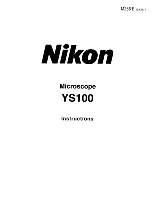
4
D. First, assure that light is available for illuminating the specimen.
1. Mirror models
a. Assure that there is a good nearby source of light (overhead light, tabletop lamp or reasonably bright natural
light).
b. Position the concave (curved) side of mirror upward.
c.
Look through eyepiece and tilt the entire mirror (tilts on either of two axis) until light appears to fill the entire
field of view.
2. Electric illuminator models.
a. Plug polarized 2 conductor plug into a standard 120 volt AC three-wire grounded outlet.
b. Rotate switch located on cord to ON position.
c.
In case of equipment malfunction, see Trouble Shooting Procedure located at the back of this manual.
3. LED cordless illuminator models.
a. Your microscope has special LED illumination that is powered by 3 rechargeable AA nickel metal hydride
batteries (supplied). These batteries may be recharged, as required, using the recharger (supplied). Each set
of batteries may be recharged approximately 1000 times before replacing, and each charge will provide up to
50 hours of microscope operation. The LED component (bulb) will last for up to 100,000 hours before
replacement is required.
WARNING
DO NOT USE regular AA alkaline batteries. Use of other than rechargeable AA nickel metal hydride
batteries could result in batteries exploding during recharge. ONLY USE THE SUPPLIED SWITCHING
BATTERY RECHARGER WITH AUTOMATIC “TRICKLE CHARGE”.
b. It is recommended that you charge the batteries before initial use and after prolonged storage as the batteries
may have discharged. Plug output cord from battery charger into DC recharging socket located on side of LED
illuminator. Your automatic switching recharger operates on 100 to 240 volts AC 50/60 Hz. Plug recharger into
your AC wall outlet. Battery recharger is also equipped with an automatic “trickle charge” feature, the red LED
indicator lamp located on recharger will be illuminated when batteries are receiving maximum charge. After
batteries are charged, the red LED indicator lamp will turn to green and charger automatically switches to
“trickle charge”. The charger can be left plugged in, but for safety reasons it is a good idea to disconnect the
charger from the AC wall outlet and the output cord from recharging socket after 12 hours. Batteries and
charger may feel warm when charging, and unplugging the recharger is a safety precaution.
c.
Turn illuminator “ON” by simply rotating the adjustable rheostat control knob located on side of illuminator.
Rotating the rheostat control knobs varies the intensity of the LED illuminator.
Note that your microscope can be used during recharging.
E. Rotate focus knobs to move eyepiece tube up (away) from stage as far as possible.
F. Place specimen slide, cover slip facing up, on stage with specimen centered over hole in middle of stage.
G. Rotate disc diaphragm to position the largest aperture under the hole in center of stage.
H. Turn the objective turret until the 4x (smallest) objective lens clicks into position in the optical path.
I.
Note that each time you change from one objective lens to another you should turn the turret until you hear the click,
which indicates that the lens is properly indexed in the optical path.
J.
While looking through the eyepiece, rotate focusing knobs until specimen comes into focus. If image does not appear in
field of view, move specimen slide slightly on stage until image appears in field of view.
K. If using Model 109 which has both coarse and fine focus knobs, you can now adjust fine focus knobs to obtain optimum
image sharpness.
L. Turn the disc diaphragm, observing that different apertures affect the sharpness of the image. Turn diaphragm until
sharpest possible image is obtained. When turning the disc diaphragm, you should hear a click as each aperture comes


























